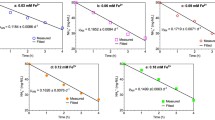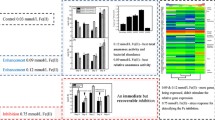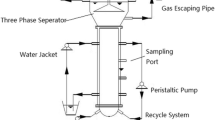Abstract
In order to explore the performance, kinetics characteristics and enhancement mechanisms in anammox process under ferrous iron enhanced conditions, a laboratory-scale UASB anammox reactor has been built up and operated for 534 days. Experimental results showed that the Anammox process was successfully started up in a short operation period and the TNRE reached 83.34 ± 2.96% with a maximum total nitrogen removal rate of 14.4 kg m−3 d−1 after long-term operated under influent Fe(II) concentration of 5.3 mg L−1. Simulation results using different kinetic models showed that the Stover–Kincannon model and the Grau second-order model were useful for describing the anammox performance under Fe(II) enhanced conditions. Extracellular polymeric substance (EPS) act a pivotal part in the granulation of Anammox sludge and the improvement of anammox activity. Iron improved the hydrophobicity of the sludge by reducing the PN/PS ratios, and also increased the Anammox granular diameter. The granular diameter of higher than 2.00 accounted for 58.3% of the total sludge. At the same time, the presence of iron decreased EPS levels, and also decreased the iron adsorption ability to sludge. More iron was transported into Anammox, which improved the nitrogen removal ability in the Anammox reactor.





Similar content being viewed by others
References
APHA (2005) Standard methods for the examination of water and wastewater, 21th edn. American Public Health Association, Washington, DC, USA
Bi Z, Qiao S, Zhou JT, Tang X, Zhang J (2014) Fast start-up of Anammox process with appropriate ferrous iron concentration. Bioresourc Technol 170:506–512
Chen JW, Ji QX, Zheng P, Chen TT, Wang CH, Mahmood Q (2010) Floatation and control of granular sludge in a high-rate anammox reactor. Water Res 44:3321–3328
Chen TT, Zheng P, Shen LD (2013) Growth and metabolism characteristics of anaerobic ammonium-oxidizing bacteria aggregates. Appl Microbiol Biot 97:5575–5583
Fan XY, Wang YL, Zhang DX, Guo YJ, Gao SH, Li ER, Zheng HL (2020) Effects of acid, acid-ZVI/PMS, Fe(II)/PMS and ZVI/PMS conditioning on the wastewater activated sludge (WAS) dewaterability and extracellular polymeric substances (EPS). J Environ Sci 91:73–84
Ferousi C, Lindhoud S, Baymann F, Kartal B, Jetten MS, Reimann J (2017) Iron assimilation and utilization in anaerobic ammonium oxidizing bacteria. Curr Opin Chem Biol 37:129–136
Grau P, Dohanyos M, Chudoba J (1975) Kinetics of multicomponent substrate removal by activated sludge. Water Res 9:637–642
Guo JB, Wang SH, Lian J, Ngo HH, Guo WS, Liu YM, Song YY (2016) Rapid start-up of the anammox process: effects of five different sludge extracellular polymeric substances on the activity of anammox bacteria. Bioresour Technol 220:641–646
Guo BB, Chen YH, Lv L, Ahmad HA, Ni SQ, Ren LY, Cui ZJ, Fang X, Qiao ZM, Ding SW (2019) Transformation of the zero valent iron dosage effect on anammox after long-term culture: From inhibition to promotion. Process Biochem 78:132–139
Hou XL, Liu ST, Zhang ZT (2015) Role of extracellular polymeric substance in determining the high aggregation ability of anammox sludge. Water Res 75:51–62
Huang XW, Wei QY, Urata K, Tomoshige Y, Zhang XH, Kawagoshi Y (2014) Kinetic study on nitrogen removal performance in marine anammox bacterial culture. J Biosci Bioeng 117:285–291
Jin RC, Zheng P (2009) Kinetics of nitrogen removal in high rate anammox upflow filter. J Hazard Mater 170:652–656
Jin LY, Zhang GM, Tian HF (2014) Current state of sewage treatment in China. Water Res 66:85–98
Kang D, Guo LY, Hu QY, Xu DD, Yu T, Li YY, Zeng Z, Li WJ, Shen XJ, Zheng P (2019) Surface convexity of anammox granular sludge: digital characterization, state indication and formation mechanism. Environ Int. https://doi.org/10.1016/j.envint.2019.105017
Kartal B, van Niftrik L, Keltjens JT, Op-den-Camp HJ, Jetten MS (2012) Anammox–growth physiology, cell biology, and metabolism. Adv Microb Physiol 60:211–262
Kuenen JG (2008) Anammox bacteria: from discovery to application. Nat Rev Microbiol 6:320–326
Li WW, Yu HQ (2014) Insight into the roles of microbial extracellular polymer substances in metal biosorption. Bioresourc Technol 160:15–23
Li YF, Pan LY, Zhu YQ, Yu YY, Wang DB, Yang GJ, Yuan XZ, Liu XR, Li HL, Zhang J (2019) How does zero valent iron activating peroxydisulfate improve the dewatering of anaerobically digested sludge? Water Res. https://doi.org/10.1016/J.WATRES.2019.114912
Lin QJ, Kang D, Zhang M, Yu T, Xu DD, Zeng Z, Zheng P (2019a) The performance of anammox reactor during start-up: enzymes tell the story. Process Saf Environ 121:247–253
Lin F, Zhu XL, Li JG, Yu PR, Luo Y, Liu MR (2019b) Effect of extracellular polymeric substances (EPS) conditioned by combined lysozyme and cationic polyacrylamide on the dewatering performance of activated sludge. Chemosphere 235:679–689
Liu J, Chakraborty S, Hosseinzadeh P, Yu Y, Tian SL, Petrik I, Bhagi A, Lu Y (2014) Metalloproteins containing cytochrome, iron–sulfur, or copper redox centers. Chem Rev 114:4366–4469
Manonmani U, Joseph K (2018) Granulation of anammox microorganisms for autotrophic nitrogen removal from wastewater. Environ Chem Lett 16:881–901
Ni SQ, Sung S, Yue QY, Gao BY (2012) Substrate removal evaluation of granular anammox process in a pilot-scale upflow anaerobic sludge blanket reactor. Ecol Eng 38:30–36
Niu QG, Zhang YL, Ma HY, He SL, Li YY (2016) Reactor kinetics evaluation and performance investigation of a long-term operated UASB-anammox mixed culture process. Int Biodeter Biodegr 108:24–33
Qiao L, Xu W, Mao SX, Li Y, Zhang YQ (2019) Study on the expanded culture and kinetics of anammox bacteria in the upper flow packed bed. Sci Total Environ 650:1173–1181
Rasmussen H, Nielsen PH (1996) Iron reduction in activated sludge measured with different extraction techniques. Water Res 30:551–558
Ren LF, Ni SQ, Liu C, Liang S, Zhang B, Kong Q, Guo N (2015) Effect of zero-valent iron on the start-up performance of anaerobic ammonium oxidation (anammox) process. Environ Sci Pollut Res 22:2925–2934
Santschi PH, Xu C, Schwehr KA, Lin P, Sun LN, Chin WC, Kamalanathan M, Bacosa HP, Quigg A (2019) Can the protein/carbohydrate (P/C) ratio of exopolymeric substances (EPS) be used as a proxy for their ‘stickiness’ and aggregation propensity? Mar Chem. https://doi.org/10.1016/j.marchem.2019.103734
Sheng GP, Yu HQ, Li XY (2010) Extracellular polymeric substances (EPS) of microbial aggregates in biological wastewater treatment systems: a review. Biotechnol Adv 28:882–894
Song YX, Liao Q, Yu C, Xiao RY, Tang CJ, Chai LY, Duan CS (2017) Physicochemical and microbial properties of settled and floating anammox granules in upflow reactor. Biochem Eng J 123:75–85
State Environmental Protection Administration of China (SEPA C) (2002) Water and wastewater monitoring methods, 4th edn. Chinese Environmental Science Publishing House, Beijing, China
Strous M, Heijnen JJ, Kuenen JG, Jetten MSM (1998) The sequencing batch reactor as a powerful tool for the study of slowly growing anaerobic ammonium-oxidizing microorganisms. Appl Microbiol Biot 50:589–596
Tang CJ, Zheng P, Zhang L, Chen JW, Mahmood Q, Chen XG, Hu BL, Wang CH, Yu Y (2010) Enrichment features of anammox consortia from methanogenic granules loaded with high organic and methanol contents. Chemosphere 79:613–619
Tang CJ, Zheng P, Wang CH, Mahmood Q, Zhang JQ, Chen XG, Zhang L, Chen JW (2011) Performance of high-loaded ANAMMOX UASB reactors containing granular sludge. Water Res 45:135–144
Tang CJ, Zheng P, Chai LY, Min XB (2013) Characterization and quantification of anammox start-up in UASB reactors seeded with conventional activated sludge. Int Biodeter Biodeg 82:141–148
van der Star WR, Abma WR, Blommers D, Mulder JW, Tokutomi T, Strous M, Picioreanu C, van Loosdrecht MC (2007) Startup of reactors for anoxic ammonium oxidation: experiences from the first full-scale anammox reactor in Rotterdam. Water Res 41:4149–4163
van der Star WR, Miclea AI, van Dongen UG, Muyzer G, Picioreanu C, van Loosdrecht MC (2008) The membrane bioreactor: a novel tool to grow anammox bacteria as free cells. Biotechnol Bioeng 101:286–294
Wei LL, Li JJ, Xue M, Wang S, Li QY, Qin KN, Jiang JQ, Ding J, Zhao QL (2019) Adsorption behaviors of Cu2+, Zn2+ and Cd2+ onto proteins, humic acid, and polysaccharides extracted from sludge EPS: Sorption properties and mechanisms. Bioresourc Technol. https://doi.org/10.1016/j.biortech.2019.121868
Wu J, Zhou HM, Li HZ, Zhang PC, Jiang J (2009) Impacts of hydrodynamic shear force on nucleation of flocculent sludge in anaerobic reactor. Water Res 43:3029–3036
Xiao KK, Chen Y, Jiang X, Yang Q, Seow WY, Zhu WY, Zhou Y (2017) Variations in physical, chemical and biological properties in relation to sludge dewaterability under Fe(II) e oxone conditioning. Water Res 109:13–23
Xu DD, Kang D, Yu T, Ding AQ, Lin QJ, Zhang M, Hu QY, Zheng P (2019) A secret of high-rate mass transfer in anammox granular sludge: Lung-like brething. Water Res 154:189–198
Yan P, Xia JS, Chen YP, Liu ZP, Guo JS, Shen Y, Zhang CC, Wang J (2017) Thermodynamics of binding interactions between extracellular polymeric substances and heavy metals by isothermal titration microcalorimetry. Bioresourc Technol 232:354–363
Yu GH, He PJ, Shao LM, He PP (2008) Stratification structure of sludge flocs with implications to dewaterability. Environ Sci 42:7944–7949
Zhang XJ, Chen Z, Zhou Y, Ma YP, Ma C, Li Y, Liang YH, Jia JP (2019) Impacts of the heavy metals Cu (II), Zn (II) and Fe (II) on an Anammox system treating synthetic wastewater in low ammonia nitrogen and low temperature: Fe(II) makes a difference. Sci Total Environ 648:798–804
Zhang JH, Miao YY, Zhang Q, Sun YW, Wu L, Peng YZ (2020) Mechanism of stable sewage nitrogen removal in a partial nitrification-anammox biofilm system at low temperatures: Microbial community and EPS analysis. Bioresourc Technol. https://doi.org/10.1016/j.biortech.2019.122459
Zhou X, Jian GM, Wang QL, Yuan ZG (2014) A review on sludge conditioning by sludge pre-treatment with a focus on advanced oxidation. RSC Adv 4:50644–50652
Acknowledgments
This study was funded by the National Natural Science Foundation of China (51808498), Natural Science Foundation of Zhejiang Province of China (No. Q17E090015) and Open Foundation from Marine Sciences in the First-Class Subjects of Zhejiang (No. 20190009).
Author information
Authors and Affiliations
Corresponding authors
Ethics declarations
Conflict of interest
All authors declare that they have no conflict of interest.
Ethical approval
This article does not contain any studies with human participants or animals performed by any of the authors.
Additional information
Publisher's Note
Springer Nature remains neutral with regard to jurisdictional claims in published maps and institutional affiliations.
Rights and permissions
About this article
Cite this article
Tang, Sm., Xu, Zh., Liu, Yl. et al. Performance, kinetics characteristics and enhancement mechanisms in anammox process under Fe(II) enhanced conditions. Biodegradation 31, 223–234 (2020). https://doi.org/10.1007/s10532-020-09905-y
Received:
Accepted:
Published:
Issue Date:
DOI: https://doi.org/10.1007/s10532-020-09905-y




